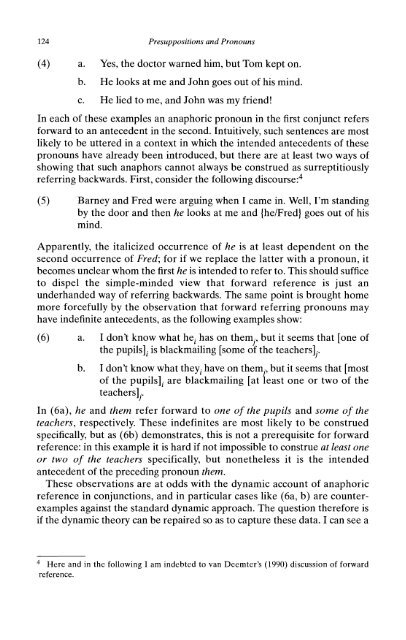Presuppositions and Pronouns - Nijmegen Centre for Semantics
Presuppositions and Pronouns - Nijmegen Centre for Semantics
Presuppositions and Pronouns - Nijmegen Centre for Semantics
Create successful ePaper yourself
Turn your PDF publications into a flip-book with our unique Google optimized e-Paper software.
124 <strong>Presuppositions</strong> <strong>and</strong> <strong>Pronouns</strong><br />
(4) a. Yes, the doctor warned him, but Tom kept on.<br />
b. He looks at me <strong>and</strong> John goes out of his mind.<br />
c. He lied to me, <strong>and</strong> John was my friend!<br />
In each of these examples an anaphoric pronoun in the first conjunct refers<br />
<strong>for</strong>ward to an antecedent in the second. Intuitively, such sentences are most<br />
likely to be uttered in a context in which the intended antecedents of these<br />
pronouns have already been introduced, but there are at least two ways of<br />
showing that such anaphors cannot always be construed as surreptitiously<br />
referring backwards. First, consider the following discourse: 4<br />
(5) Barney <strong>and</strong> Fred were arguing when I came in. Well, I'm st<strong>and</strong>ing<br />
by the door <strong>and</strong> then he looks at me <strong>and</strong> {he/Fred} goes out of his<br />
mind.<br />
Apparently, the italicized occurrence of he is at least dependent on the<br />
second occurrence of Fred; <strong>for</strong> if we replace the latter with a pronoun, it<br />
becomes unclear whom the first he is intended to refer to. This should suffice<br />
to dispel the simple-minded view that <strong>for</strong>ward reference is just an<br />
underh<strong>and</strong>ed way of referring backwards. The same point is brought home<br />
more <strong>for</strong>cefully by the observation that <strong>for</strong>ward referring pronouns may<br />
have indefinite antecedents, as the following examples show:<br />
(6) a. I don't know what he i ; has on them, , j but it seems that [one of<br />
the pupils]^ pupils]i is blackmailing [some of the teachers]t teachers].<br />
b. I don't know what theYi they z have on them, , j but it seems that [most<br />
of the pupils], pupils]i are blackmailing [at least one or two of the<br />
teachers]t teachers].<br />
In (6a), he <strong>and</strong> them refer <strong>for</strong>ward to one of the pupils <strong>and</strong> some of the<br />
teachers, respectively. These indefinites are most likely to be construed<br />
specifically, but as (6b) demonstrates, this is not a prerequisite <strong>for</strong> <strong>for</strong>ward<br />
reference: in this example it is hard if not impossible to construe at least one<br />
or two of the teachers specifically, but nonetheless it is the intended<br />
antecedent of the preceding pronoun them.<br />
These observations are at odds with the dynamic account of anaphoric<br />
reference in conjunctions, <strong>and</strong> in particular cases like (6a, b) are counterexamples<br />
against the st<strong>and</strong>ard dynamic approach. The question there<strong>for</strong>e is<br />
counter-<br />
if the dynamic theory can be repaired so as to capture these data. I can see a<br />
4<br />
4 Here <strong>and</strong> in the following I am indebted to van Deemter's (1990) discussion of <strong>for</strong>ward<br />
reference.














